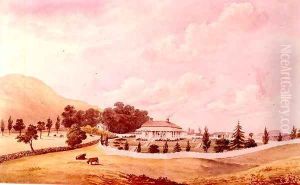John Barr Clark Hoyte Paintings
John Barr Clark Hoyte was a British-born artist known for his landscape paintings, particularly of New Zealand. He was born on August 31, 1835, in London, England. Hoyte showed an early interest in art and pursued his passion through study and practice. He received his artistic training in England and worked there for a few years before emigrating to New Zealand.
In 1861, Hoyte arrived in Auckland, New Zealand, which at that time was a burgeoning colony. His arrival coincided with a period of significant growth and development for the country, which provided him with ample inspiration and subject matter for his work. He became a key figure in the art scene of Auckland and was a founding member of the Society of Artists in Auckland. His landscapes are particularly noted for their romantic and picturesque qualities, capturing the dramatic and varied scenery of New Zealand.
Throughout his career, Hoyte held several positions, including that of an art teacher, which allowed him to influence a generation of New Zealand artists. He was also employed as a draughtsman in the Survey Department, which further honed his skills in rendering landscapes with accuracy and detail. Hoyte’s work was widely exhibited and collected in his time, and he held numerous exhibitions in New Zealand and abroad.
Hoyte's contributions to New Zealand art were significant, as he documented the country's landscapes during a key period of its development. His paintings acted as visual records of the environment and were celebrated for their clarity, light, and composition. In 1878, Hoyte returned to England, where he continued to paint and exhibit his New Zealand landscapes, which remained popular with British audiences.
John Barr Clark Hoyte lived out the remainder of his life in England, where he continued to paint and exhibit his work. He passed away on February 25, 1913, in Torquay, Devon, England. His legacy endures in the collections of major New Zealand institutions and in the esteem of art historians who recognize him as an important figure in the country’s artistic heritage. His works continue to be appreciated for their contribution to the visual history of New Zealand and for their artistic merit.
